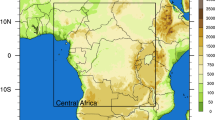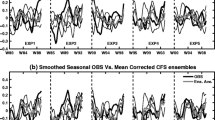Abstract
Using observations and 1-month lead hindcast data from six coupled atmosphere–ocean climate models, this study investigates the interdecadal change in the leading maximum covariance analysis mode (MCA1) of atmospheric circulation in response to the changes in the El Niño and Southern Oscillation (ENSO) occurred around late 1970s. We focus on boreal winter climate variability and predictability over the North Pacific–North American (NPNA) region using December–January–February prediction initiated from November 1st in the period of 1960–1980 (P1) and 1981–2001 (P2). Observed analysis reveals that ENSO variability, the related tropical convective activity, and thus the MCA1 are considerably enhanced from P1 to P2. As a result, surface climate anomalies over the NPNA are more significantly correlated with the MCA1 in P2 than P1, particularly over North America. The six coupled models and their multi-model ensemble not only are capable of capturing the interdecadal change of the MCA1 and its relationship with surface air temperature and precipitation over the NPNA regions but also have significantly higher forecast skills for the MCA1 and the surface climate anomalies in P2 than P1. However, models have systematic biases in the spatial distribution of the MCA1. It is demonstrated that the interdecadal change in the MCA1 should contribute to the improved forecast skill of the NPNA climate during recent epoch.












Similar content being viewed by others
References
Alessandri A, Borrelli A, Masina S et al (2010) The ingv-cmcc seasonal prediction system: improved ocean initial conditions. Mon Weather Rev 138:3634–3649
Alessandri A, Borrelli A, Navarra A, Arribas A, Déqué M, Rogel P, Weisheimer A (2011) Evaluation of probabilistic quality and value of the ensembles multi-model seasonal forecasts: comparison with demeter. Mon Weather Rev 139:581–607
An SI, Wang B (2000) Interdecadal change of the structure of the enso mode and its impact on the enso frequency. J Clim 13:2044–2055
Balmaseda M, Vidard A, Anderson DLT (2008) The ECMWF ora-s3 ocean analysis system. Mon Weather Rev 136:3018–3014
Barnston A, Livezey R, Halpert M (1991) Modulation of southern oscillation-northern hemisphere mid-winter climate relationships by the qbo. J Clim 4:203–217
Borrelli AAA, Gualdi S, Scoccimarro E, Masina S (2011) Tropical cyclone count forecasting using a dynamical seasonal prediction system: sensitivity to improved ocean initialization. J Clim 24:2963–2982
Brankovic C, Palmer T (2000) Seasonal skill and predictability of ecmwf provost ensembles. Q J R Meteorol Soc 126:2035–2067
Chen M, Xie P, Janowiak J, Arkin P (2002) Global land precipitation: a 50-yr monthly analysis based on gauge observations. J Hydrometeorol 3:249–266
Chowdary J, Xie SP, Lee JY, Kosaka Y, Wang B (2010) Predictability of summer northwest pacific climate in eleven coupled model hindcasts: local and remote forcing. J Geophys Res 115:D22,121
Collins W et al (2008) Evaluation of the hadgem2 model. Technical note HCTN 74, Met Off Hadley Cent, Exeter, UK, http://www.metoffice.gov.uk/publications/HCTN/index.html
Daget N, Weaver AT, Balmaseda MA (2009) Ensemble estimation of background-error variances in a three-dimensional variational data assimilation system for the global ocean. Q J R Meteorol Soc 135:1071–1094
Graham N (1992) Decadal scale climate variability in the 1970s and 1980s: observations and model results: decadal-to-century time scales of climate variability. Academic, New York
Gu D, Philander S (1997) Interdecadal climate fluctuations that depend on exchanges between the tropics and extratropics. Sciences 275:805–807
Ha KJ, Chu JE, Lee JY, Wang B (2012) What caused the cool summer over northern central asia, east asia, and central north america during 2009? Environ Res Lett 7:44015. doi:10.1088/1748-9326/7/4/044015
Hoskins B, Karoly D (1981) The steady linear responses of a spherical atmosphere to thermal and orographic forcing. J Atmos Sci 38:1179–1196
Jia X, Lin H (2011) Influence of forced large-scale atmospheric patterns on surface air temperature in China. Mon Weather Rev 139:830–852
Jia X, Lin H, Derome J (2009) The influence of tropical pacific forcing on the Arctic oscillation. Clim Dyn 32:495–509
Jia X, Lin H, Derome J (2010) Improving seasonal forecast skill of North American surface air temperature in fall using a post-processing method. Mon Weather Rev 138:1843–1857
Jia X, Lin H, Lee JY, Wang B (2012) Season-dependent forecast skill of the dominant atmospheric circulation patterns over the Pacific North-American region. J Clim 25:7248–7265
Jia X, Lee JY, Lin H (2013) Interdecadal change in the northern hemisphere seasonal climate prediction: part II. Predictability and prediction skill. Clim Dyn (under review)
Kalnay E, Kanamitsu M et al (1996) The ncep/ncar 40-year reanalysis project. Bull Am Meteorol Soc 77:437–471
Keenlyside N, Latif M, Botzet M et al (2005) A coupled method for initializing el nino southern oscillation forecasts using sea surface temperature. Tellus Ser A 57:340–356
Kim ST, Yu JY (2012) The two types of enso in cmip5 models. Geophys Res Lett 39:L11,704
Lee JY, Wang B (2012a) Future change of global monsoon in the CMIP5. Clim Dyn. doi:10.1007/s00382-012-1564-0
Lee JY, Wang B (2012b) Seasonal climate prediction and predictability of atmospheric circulation. In Druyan LM (ed) Climate models. InTech open access Book pp 19–42. doi:10.5772/33782
Lee JY, Wang B, Kang IS et al (2010) How are seasonal prediction skills related to models performance on mean state and annual cycle? Clim Dyn 35:267–283
Lee JY, Wang B, Ding Q, Ha KJ, Ahn JB, Kumar A, Stern B, Alves O (2011a) How predictable is the NH summer upper-tropospheric circulation? Clim Dyn 37:1189–1203
Lee SS, Lee JY, Ha KJ, Wang B, Schemm JKE (2011b) Deficiencies and possibilities for long-lead coupled climate prediction of the Western North Pacific-East Asian summer monsoon. Clim Dyn 36:1173–1188
Lee JY, Lee SS, Wang B, Ha KJ, Jhun JG (2013) Seasonal prediction and predictability of the asian winter temperature variability. Clim Dyn 41:573–587
Melia DS (2002) A global coupled sea ice-ocean model. Ocean Model 4:137–172
Nakaegawa T, Kanamitsu M (2004) Interdecadal trend of prediction skill in an ensemble amip-type experiment. J Clim 17:2881–2889
Peng P, Kumar A, Barnston A, Goddard L (2000) Simulation skills of the sst-forced global climate variability of the ncep-mrf9 and scripps/mpi echam3 models. J Clim 13:3657–3679
Rayner N, Parker DE, Horton EB, Folland CK, Alexander LV, Rowell DP, Kent EC, Kaplan A (2003) Global analyses of sea surface temperature, sea ice, and night marine air temperature since the late nineteenth century. J Geophys Res. doi:10.1029/2002JD002670
Shukla J, Anderson J, Baumhefner D, Brankovic C, Chang Y, Kalnay E, Marx L, Palmer T, Paolino D, Ploshay J, Schubert S, Straus D, Suarez M, Tribbia J (2000) Dynamical seasonal prediction. Bull Am Meteorol Soc 11:2593–2606
Tang Y, Deng Z, Zhou X, Cheng Y (2008) Interdecadal variation of enso predictability in multiple models. J Clim 21:4811–4833
Wallace J, Rasmusson E, Mitchell T et al (1998) On the structure and evolution of enso-related climate variability in the tropical pacific: lessons. J Geophy Res 103:14241–14259
Wang B (1995) Interdecadal changes in el nino onset in the last four decades. J Clim 8:267–285
Wang B, Wang Y (1996) Temporal structure of the southern oscillation as revealed by waveform and wavelet analysis. J Clim 9:1586–1598
Wang B, Lee JY, Kang IS et al (2008) How accurately do coupled climate models predict the leading modes of Asian-Australian monsoon interannual variability? Clim Dyn 30:605–619
Wang B, Lee JY, Shukla J, Kang IS, Park CK et al (2009) Advance and prospectus of seasonal prediction: assessment of apcc/clipas 14-model ensemble retrospective seasonal prediction (1980–2004). Clim Dyn 33:93–117
Weisheimer A, Doblas-Reyes FJ et al (2009) Ensembles: a new multi-model ensemble for seasonal-to-annual predictions-skill and progress beyond demeter in forecasting tropical pacific ssts. Geophys Res Lett 36:L21,711
Xue Y, Smith T, Reynolds W (2003) Interdecadal changes of 30-year sst normal during 1871–2000. J Clim 16:1601–1612
Zhong A, Hendon H, Alves O (2005) Indian ocean variability and its association with ENSO in a global coupled model. J Clim 18:3634–3649
Acknowledgments
This research was jointly funded by National Natural Sciences Fundation of China (Grant 41105037) and by the Natural Science and Engineering Research Council of Canada (NSERC). Lee and Ha were supported by the National Research Foundation of Korea (NRF) through a Global Research Laboratory (GRL) grant (MEST 2011-0021927). This work was partially supported by the APEC Climate Center (APCC) international research project and the European Union Seventh Framework Programme (FP7/2007-13) under the grant agreement n. 303208 (CLIMITS project) and under the grant agreement n. 308378 (SPECS project). We are grateful to the two reviewers for their helpful suggestions on improving our paper.
Author information
Authors and Affiliations
Corresponding author
Rights and permissions
About this article
Cite this article
Jia, X., Lee, JY., Lin, H. et al. Interdecadal change in the Northern Hemisphere seasonal climate prediction skill: part I. The leading forced mode of atmospheric circulation. Clim Dyn 43, 1595–1609 (2014). https://doi.org/10.1007/s00382-013-1988-1
Received:
Accepted:
Published:
Issue Date:
DOI: https://doi.org/10.1007/s00382-013-1988-1




